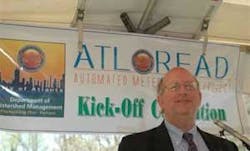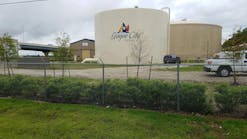Fixed network data collectors were installed to read large commercial meters in downtown Atlanta.
Click here to enlarge imageThe remainder of residential meters will be read using mobile data collectors. Before the conversion, 30 meter readers were required to read the meters. Upon the project completion in July 2009, only two readers will be needed every other day at the most. Since the city currently contracts for that labor, the new mobile system will quickly pay for itself, Glover said.
Another “huge benefit” of the system, Booth added, is the ability to quickly identify meters that have been tampered with – now the department will know whether an act of vandalism signals a repeat offense or whether it needs to focus more attention on a specific residence.
Communication
Part of the overall plan for the project was a communications effort to inform customers of the change. The communications plan began in June 2006, six months before implementation, and continues today.
The city has Neighborhood Planning Units (NPU), and a representative of the Department of Watershed Management program attends each monthly NPU meeting to give an update on upcoming and ongoing projects.
The department developed a logo for the AMR program, “ATL Read.” That logo appears on a postcard mailed two weeks ahead of any installation or changeout along with an overview and the benefits of AMR. Bill inserts and door hangers also feature the logo.
Additionally, the city posted the message to its website and on billboards and distributed press releases to the local media. At the AMR kickoff, news stations televised the installation of a meter at a customer’s house as residents came up and asked questions.
The department has assured its residential customers that their bills will be accurate, earning “overwhelmingly positive feedback,” Booth said. “They were curious, wanting to know how the technology worked and that sort of thing.”
“Our large commercial customers saw it as a win-win,” said Glover, since the city eliminated estimated billing and began implementing a targeted fixed network system that will provide daily water consumption data for the targeted commercial meters.
A year and a half into the implementation of its ARB Utility Management System, the department is enthusiastic about the results it has seen. Reading and billing turnaround time has improved drastically making it easier to resolve billing issues. But the most immediate benefit, according to Booth, is “the accuracy of the readings themselves. No transposed numbers – it’s a hyper-accurate reading in each case.”





